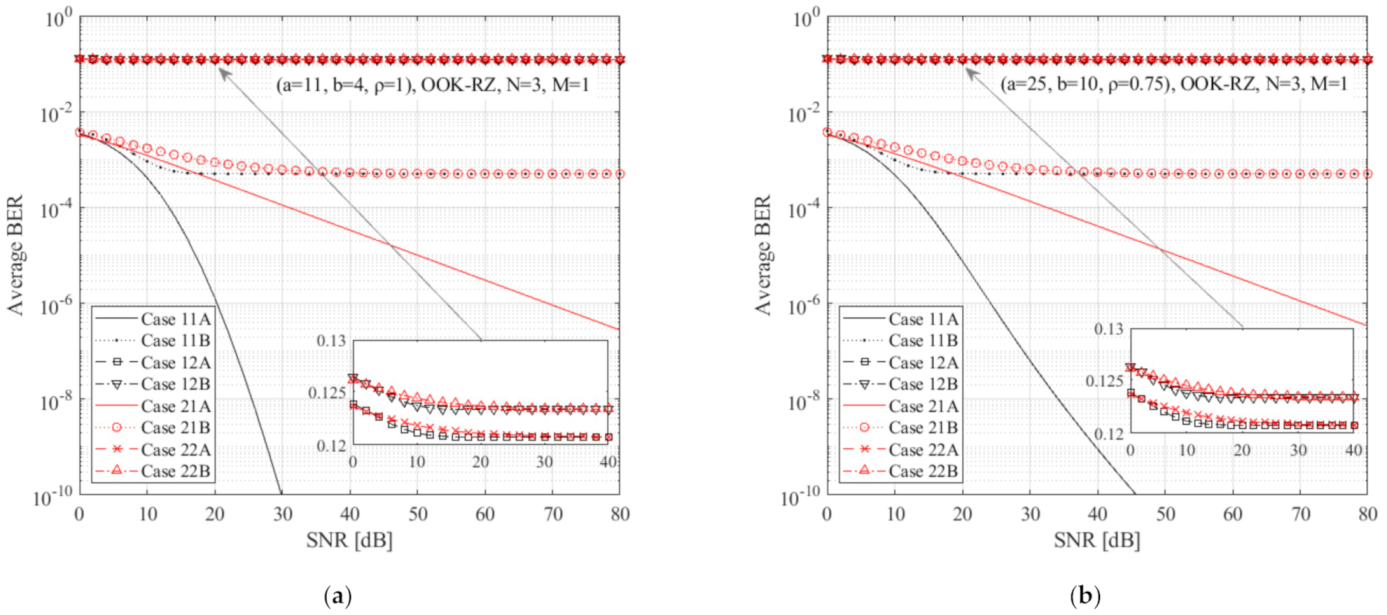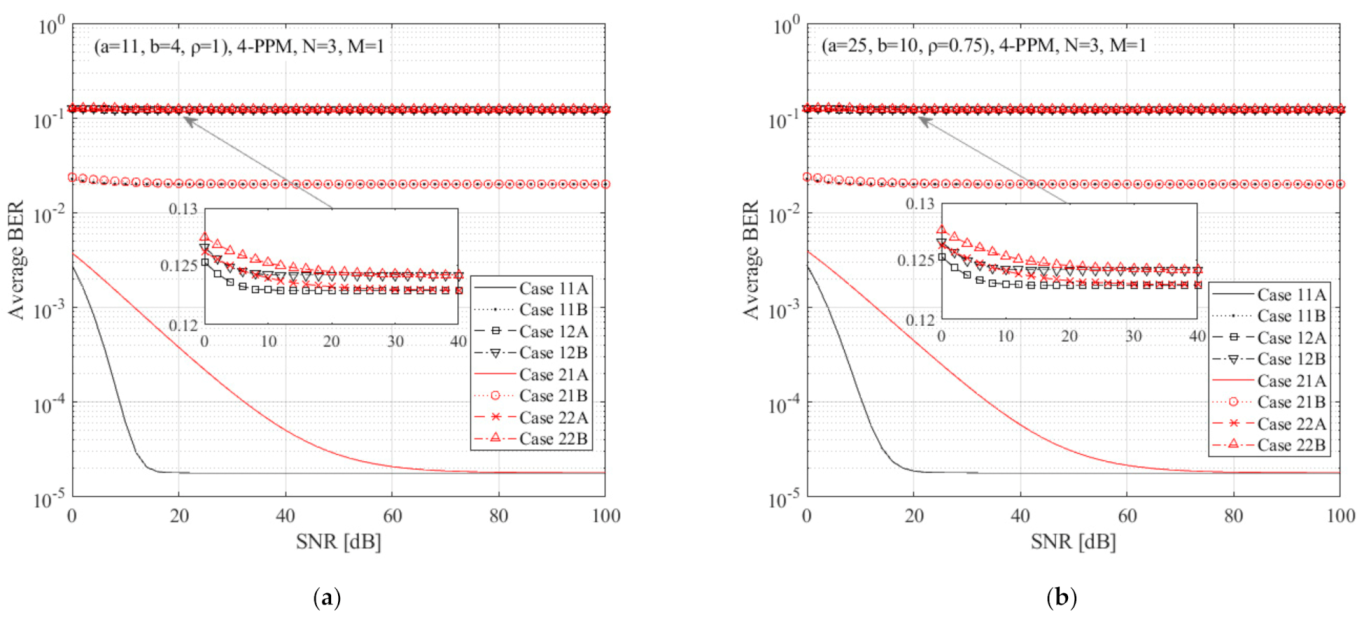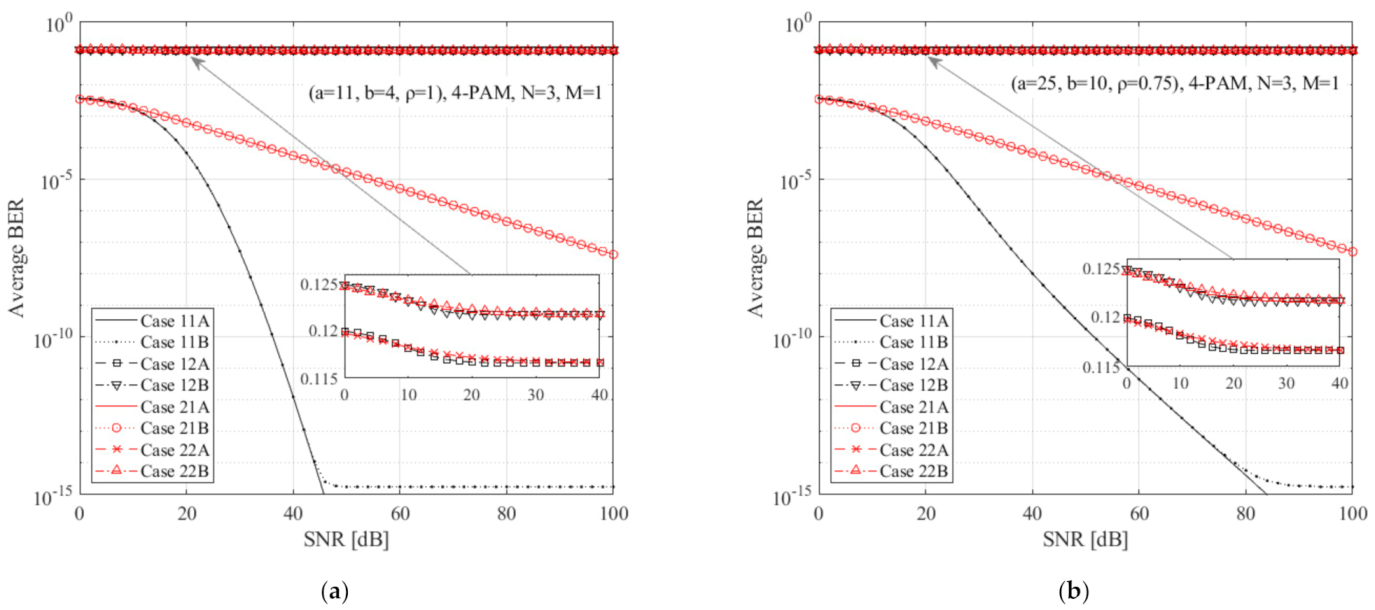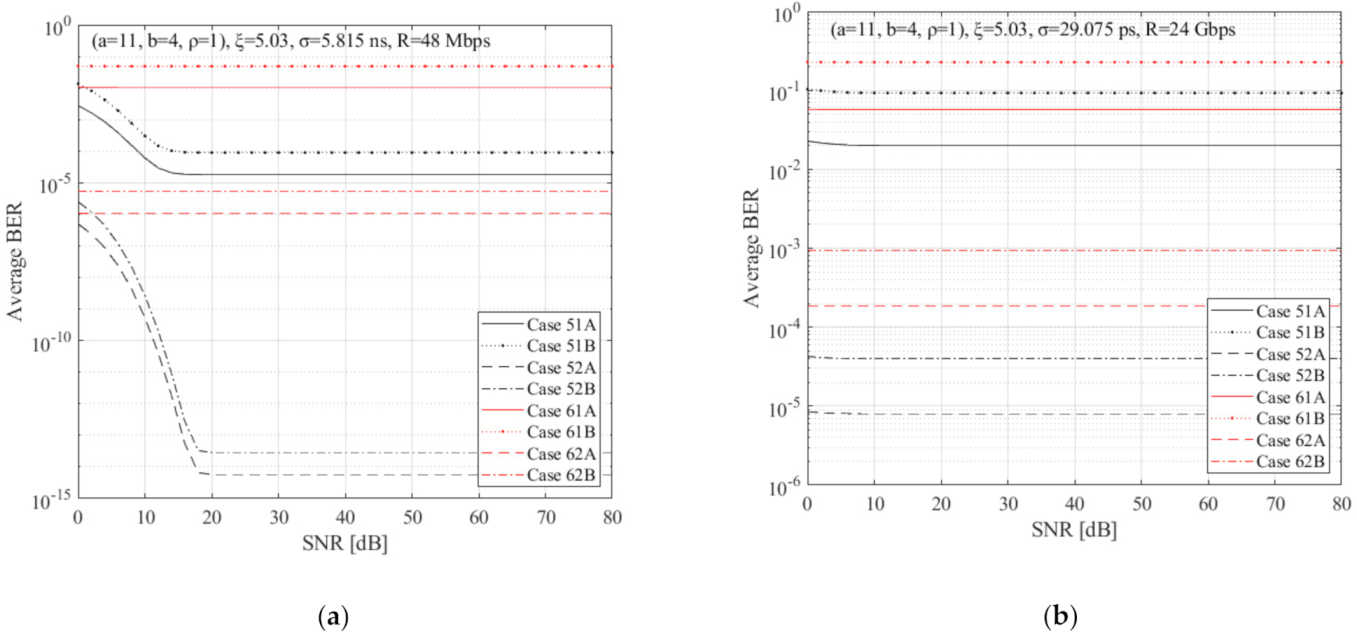Time and Spatial Jitter Influence on the Performance of FSO Links with DF Relays and OC Diversity Over Turbulence Channels
Abstract
:1. Introduction
2. System Model
2.1. Turbulence Effect
2.2. Spatial Jitter Effect
2.3. Joint Effect of Turbulence and Spatial Jitter
2.4. Time Jitter Effect
3. BER Performance Estimation
3.1. Instantaneous BER Performances for Various Modulation Schemes
3.2. Average BER Performances Due to Turbulence and SJ Influence
3.3. Average BER Performances Due to TJ Influence
3.4. Individual Total Average BER Performances
3.5. Relayed Total Average BER Performances
4. Numerical Results
5. Discussion
6. Conclusions
Author Contributions
Funding
Institutional Review Board Statement
Informed Consent Statement
Data Availability Statement
Conflicts of Interest
References
- Kedar, D.; Arnon, S. Urban optical wireless communication networks: The main challenges and possible solutions. IEEE Commun. Mag. 2004, 42, S2–S7. [Google Scholar] [CrossRef]
- Arnon, S. Optical Wireless Communications; Marcel Dekker Inc.: New York, NY, USA, 2003. [Google Scholar]
- Henniger, H.; Ludwig, A.; Horwath, J. Performance bounds of DPSK and OOK for low elevation optical LEO downlinks. Radioengineering 2010, 19, 589–595. [Google Scholar]
- Popoola, W.; Ghassemlooy, Z.; Lee, C.; Boucouvalas, A. Scintillation effect on intensity modulated laser communication systems—A laboratory demonstration. Opt. Laser Technol. 2010, 42, 682–692. [Google Scholar] [CrossRef]
- Andrews, L.C.; Phillips, R.L.; Young, C.Y. Laser Beam Scintillation with Applications; SPIE: Bellingham, WA, USA, 2001. [Google Scholar] [CrossRef] [Green Version]
- Andrews, L.C.; Al-Habash, M.A.; Hopen, C.Y.; Phillips, R.L. Theory of optical scintillation: Gaussian-beam wave model. Waves Random Media 2001, 11, 271–291. [Google Scholar] [CrossRef]
- Mahdieh, M.H.; Pournoury, M. Atmospheric turbulence and numerical evaluation of bit error rate (BER) in free-space communication. Opt. Laser Technol. 2010, 42, 55–60. [Google Scholar] [CrossRef]
- Tsiftsis, T.A.; Sandalidis, H.G.; Karagiannidis, G.K.; Uysal, M. Optical wireless links with spatial diversity over strong atmospheric turbulence channels. IEEE Trans. Wirel. Commun. 2009, 8, 951–957. [Google Scholar] [CrossRef] [Green Version]
- Moradi, H.; Falahpour, M.; Reafi, H.H.; LoPresti, P.G.; Atiquzzaman, M. Availability Modeling of FSO/RF Mesh Networks through Turbulence-Induced Fading Channels. In Proceedings of the 2010 INFOCOM IEEE Conference on Computer Communications Workshops, San Diego, CA, USA, 15–19 March 2010. [Google Scholar]
- Zhang, Y.; Si, C.; Wang, Y.; Wang, J.; Jia, J. Capacity for non-Kolmogorov turbulent optical links with beam wander and pointing errors. Opt. Laser Technol. 2011, 43, 1338–1342. [Google Scholar] [CrossRef]
- Upadhya, A.; Dwivedi, V.K.; Karagiannidis, G.K. On the Effect of Interference and Misalignment Error in Mixed RF/FSO Systems Over Generalized Fading Channels. IEEE Trans. Commun. 2020, 68, 3681–3695. [Google Scholar] [CrossRef]
- Jurado-Navas, A.; Maria, J.; Francisco, J.; Puerta-Notario, A. A Unifying Statistical Model for Atmospheric Optical Scintillation. Numer. Simul. Phys. Eng. Process. 2011, 1–4. [Google Scholar] [CrossRef] [Green Version]
- Jurado-Navas, A.; Balsells, J.M.G.; Paris, J.F.; Vázquez, M.D.C.; Notario, A.P. Impact of pointing errors on the performance of generalized atmospheric optical channels. Opt. Express 2012, 20, 12550–12562. [Google Scholar] [CrossRef]
- Sandalidis, H. Optimization Models for Misalignment Fading Mitigation in Optical Wireless Links. IEEE Commun. Lett. 2008, 12, 395–397. [Google Scholar] [CrossRef]
- Islam, K.M.N.; Majumder, S.P. Effect of timing jitter on the BER performance of a M-PPM FSO link over atmospheric turbulence channel. In Proceedings of the 8th International Conference on Electrical and Computer Engineering, Dhaka, Bangladesh, 20–22 December 2014; pp. 409–412. [Google Scholar] [CrossRef]
- Essiambre, R.-J.; Agrawal, G.P. Timing jitter analysis for optical communication systems using ultrashort solitons and dispersion-decreasing fibers. Opt. Commun. 1996, 131, 274–278. [Google Scholar] [CrossRef]
- Li, Y.; Geng, T.; Ma, S.; Gao, S. Timing jitter’s influence on the symbol error rate performance of the L -ary pulse position modulation free-space optical link in atmospheric turbulent channels with pointing errors. Opt. Eng. 2017, 56, 36116. [Google Scholar] [CrossRef]
- Lazer, N.; Teen, Y.P.A. Free Space Optical Communication and Laser Beam Propagation through Turbulent Atmosphere: A Brief Survey. In Proceedings of the 2019 International Conference on Recent Advances in Energy-efficient Computing and Communication (ICRAECC), Nagercoil, India, 7–8 March 2019. [Google Scholar] [CrossRef]
- Wang, Y.; Zhang, Y.; Dou, Z.; Tian, D. The Influence of Timing Error on the Performance of Optical Pulse PPM System in Atmospheric Turbulent Channels. In Proceedings of the 2010 Symposium on Photonics and Optoelectronics, Chengdu, China, 19–21 June 2010; pp. 1–4. [Google Scholar] [CrossRef]
- Hamming, R.W. Error Detecting and Error Correcting Codes. Bell Syst. Tech. J. 1950, 29, 147–160. [Google Scholar] [CrossRef]
- Sheng, M.; Jiang, P.; Hu, Q.; Su, Q.; Xie, X.-X. End-to-end average BER analysis for multihop free-space optical communications with pointing errors. J. Opt. 2013, 15. [Google Scholar] [CrossRef]
- Ai, Y.; Mathur, A.; Cheffena, M.; Bhatnagar, M.R.; Lei, H. Physical Layer Security of Hybrid Satellite-FSO Cooperative Systems. IEEE Photonics J. 2019, 11, 1–14. [Google Scholar] [CrossRef]
- Xu, F.; Khalighi, A.; Caussé, P.; Bourennane, S. Channel coding and time-diversity for optical wireless links. Opt. Express 2009, 17, 872–887. [Google Scholar] [CrossRef] [PubMed]
- Gripeos, P.; Nistazakis, H.; Roumelas, G.; Christofilakis, V.; Tsigopoulos, A.; Tombras, G. DF Relayed OOK and PAM FSO Links with Turbulence and Time Jitter. In Proceedings of the 2020 International Conference on Broadband Communications for Next Generation Networks and Multimedia Applications (CoBCom), Graz, Austria, 7–9 July 2020; pp. 1–7. [Google Scholar]
- Brennan, D. Linear Diversity Combining Techniques. Proc. IRE 1959, 47, 1075–1102. [Google Scholar] [CrossRef]
- Simon, M.K.; Alouini, M.-S. Digital Communication Over Fading Channels; Wiley-Interscience: New York, NY, USA, 2000. [Google Scholar]
- Nistazakis, H.E. A time-diversity scheme for wireless optical links over exponentially modeled turbulence channels. Optik 2013, 124, 1386–1391. [Google Scholar] [CrossRef]
- Navidpour, S.M.; Uysal, M.; Kavehrad, M. BER Performance of Free-Space Optical Transmission with Spatial Diversity. IEEE Trans. Wirel. Commun. 2007, 6, 2813–2819. [Google Scholar] [CrossRef] [Green Version]
- Wang, Z.; Zhong, W.-D.; Fu, S.; Lin, C. Performance comparison of different modulation formats over free-space optical (FSO) turbulence links with space diversity reception technique. IEEE Photonics J. 2009, 1, 277–285. [Google Scholar] [CrossRef]
- Shin, E.J.; Chan, V.W.S. Optical communication over the turbulent atmospheric channel using spatial diversity. In Proceedings of the Global Telecommunications Conference, GLOBECOM ’02, Taipei, Taiwan, 17–21 November 2002; Volume 3. [Google Scholar] [CrossRef]
- Mishra, N.; Kumar, D.S. Outage analysis of relay assisted FSO systems over K-distribution turbulence channel. In Proceedings of the 2016 International Conference on Electrical, Electronics, and Optimization Techniques (ICEEOT), Chennai, India, 3–5 March 2016; pp. 2965–2967. [Google Scholar]
- Garrido-Balsells, J.M.; Lopez-Martinez, F.J.; Castillo-Vázquez, M.; Jurado-Navas, A.; Puerta-Notario, A. Performance analysis of FSO communications under LOS blockage. Opt. Express 2017, 25, 25278–25294. [Google Scholar] [CrossRef] [PubMed] [Green Version]
- Modified Bessel Function of the Second Kind: Representations through More General Functions (Formula 03.04.26.0009). Available online: https://functions.wolfram.com/03.04.26.0009.01 (accessed on 29 July 2021).
- Adamchik, V.S.; Marichev, O.I. The algorithm for calculating integrals of hypergeometric type functions and its realization in REDUCE system. In Proceedings of the International Symposium on Symbolic and Algebraic Computation—ISSAC ’90, Tokyo, Japan, 20–24 August 1990. [Google Scholar]
- Al-Habash, M.A. Mathematical model for the irradiance probability density function of a laser beam propagating through turbulent media. Opt. Eng. 2001, 40, 1554. [Google Scholar] [CrossRef]
- Jakeman, E. On the statistics of K-distributed noise. J. Phys. A Math. Gen. 1980, 13, 31–48. [Google Scholar] [CrossRef]
- Ninos, M.; Nistazakis, H.; Tombras, G. On the BER performance of FSO links with multiple receivers and spatial jitter over gamma-gamma or exponential turbulence channels. Optik 2017, 138, 269–279. [Google Scholar] [CrossRef]
- Farid, A.A.; Hranilovic, S. Outage Capacity Optimization for Free-Space Optical Links With Pointing Errors. J. Light. Technol. 2007, 25, 1702–1710. [Google Scholar] [CrossRef] [Green Version]
- Sandalidis, H.G.; Tsiftsis, T.A.; Karagiannidis, G.K. Optical Wireless Communications With Heterodyne Detection Over Turbulence Channels With Pointing Errors. J. Light. Technol. 2009, 27, 4440–4445. [Google Scholar] [CrossRef]
- Gappmair, W. Novel results on pulse-position modulation performance for terrestrial free-space optical links impaired by turbulent atmosphere and pointing errors. IET Commun. 2012, 6, 1300–1305. [Google Scholar] [CrossRef]
- Varotsos, G.; Nistazakis, H.; Petkovic, M.; Djordjevic, G.; Tombras, G. SIMO optical wireless links with nonzero boresight pointing errors over M modeled turbulence channels. Opt. Commun. 2017, 403, 391–400. [Google Scholar] [CrossRef]
- Nadarajah, S. A generalized normal distribution. J. Appl. Stat. 2005, 32, 685–694. [Google Scholar] [CrossRef]
- Hranilovic, S. Wireless Optical Communication Systems; Springer: New York, NY, USA, 2005; pp. 51–64. [Google Scholar] [CrossRef]
- Proakis, J.G.; Salehi, M. Communication Systems Engineering, 2nd ed.; Prentice Hall: Hoboken, NJ, USA, 2002. [Google Scholar]
- Loskot, P.; Beaulieu, N.C. Prony and Polynomial Approximations for Evaluation of the Average Probability of Error Over Slow-Fading Channels. IEEE Trans. Veh. Technol. 2008, 58, 1269–1280. [Google Scholar] [CrossRef]
- Meijer G-Function: Integration (Formula 07.34.21.0013). Available online: https://functions.wolfram.com/HypergeometricFunctions/MeijerG/21/02/03/01/0002/ (accessed on 14 February 2021).
- Exponential Function: Representations through More General Functions (Formula 01.03.26.0004). Available online: https://functions.wolfram.com/01.03.26.0004.01 (accessed on 29 July 2021).
- Roumelas, G.; Nistazakis, H.; Gappmair, W.; Gripeos, P.; Christofilakis, V. Time jitter influence on the performance of gamma–gamma turbulence FSO links with various modulation schemes. J. Mod. Opt. 2020, 67, 721–729. [Google Scholar] [CrossRef]
- Morgado, E.; Mora-Jimenez, I.; Vinagre, J.J.; Ramos-López, J.; Caamano, A.J. End-to-End Average BER in Multihop Wireless Networks over Fading Channels. IEEE Trans. Wirel. Commun. 2010, 9, 2478–2487. [Google Scholar] [CrossRef] [Green Version]







Publisher’s Note: MDPI stays neutral with regard to jurisdictional claims in published maps and institutional affiliations. |
© 2021 by the authors. Licensee MDPI, Basel, Switzerland. This article is an open access article distributed under the terms and conditions of the Creative Commons Attribution (CC BY) license (https://creativecommons.org/licenses/by/4.0/).
Share and Cite
Gripeos, P.J.; Nistazakis, H.E.; Tsigopoulos, A.D.; Christofilakis, V.; Roditi, E. Time and Spatial Jitter Influence on the Performance of FSO Links with DF Relays and OC Diversity Over Turbulence Channels. Photonics 2021, 8, 318. https://doi.org/10.3390/photonics8080318
Gripeos PJ, Nistazakis HE, Tsigopoulos AD, Christofilakis V, Roditi E. Time and Spatial Jitter Influence on the Performance of FSO Links with DF Relays and OC Diversity Over Turbulence Channels. Photonics. 2021; 8(8):318. https://doi.org/10.3390/photonics8080318
Chicago/Turabian StyleGripeos, Panagiotis J., Hector E. Nistazakis, Andreas D. Tsigopoulos, Vasilis Christofilakis, and Evgenia Roditi. 2021. "Time and Spatial Jitter Influence on the Performance of FSO Links with DF Relays and OC Diversity Over Turbulence Channels" Photonics 8, no. 8: 318. https://doi.org/10.3390/photonics8080318







